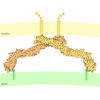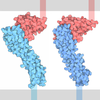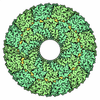+ データを開く
データを開く
- 基本情報
基本情報
| 登録情報 | データベース: PDB / ID: 5lfu | |||||||||
|---|---|---|---|---|---|---|---|---|---|---|
| タイトル | Myelin-associated glycoprotein (MAG) glycosylated and lysine-methylated full extracellular domain | |||||||||
 要素 要素 | Myelin-associated glycoprotein | |||||||||
 キーワード キーワード | CELL ADHESION / Myelin / Signaling | |||||||||
| 機能・相同性 |  機能・相同性情報 機能・相同性情報mesaxon / Axonal growth inhibition (RHOA activation) / Basigin interactions / myelin sheath adaxonal region / ganglioside GT1b binding / sialic acid binding / central nervous system myelination / central nervous system myelin formation / : / negative regulation of axon extension ...mesaxon / Axonal growth inhibition (RHOA activation) / Basigin interactions / myelin sheath adaxonal region / ganglioside GT1b binding / sialic acid binding / central nervous system myelination / central nervous system myelin formation / : / negative regulation of axon extension / positive regulation of astrocyte differentiation / positive regulation of myelination / paranode region of axon / Schmidt-Lanterman incisure / axon regeneration / negative regulation of neuron differentiation / transmission of nerve impulse / myelination / cellular response to mechanical stimulus / myelin sheath / negative regulation of neuron projection development / carbohydrate binding / negative regulation of neuron apoptotic process / cell adhesion / membrane raft / signaling receptor binding / protein kinase binding / protein homodimerization activity / plasma membrane 類似検索 - 分子機能 | |||||||||
| 生物種 |  | |||||||||
| 手法 |  X線回折 / X線回折 /  シンクロトロン / シンクロトロン /  分子置換 / 解像度: 4.3 Å 分子置換 / 解像度: 4.3 Å | |||||||||
 データ登録者 データ登録者 | Pronker, M.F. / Janssen, B.J.C. | |||||||||
| 資金援助 |  オランダ, 1件 オランダ, 1件
| |||||||||
 引用 引用 |  ジャーナル: Nat Commun / 年: 2016 ジャーナル: Nat Commun / 年: 2016タイトル: Structural basis of myelin-associated glycoprotein adhesion and signalling. 著者: Matti F Pronker / Suzanne Lemstra / Joost Snijder / Albert J R Heck / Dominique M E Thies-Weesie / R Jeroen Pasterkamp / Bert J C Janssen /  要旨: Myelin-associated glycoprotein (MAG) is a myelin-expressed cell-adhesion and bi-directional signalling molecule. MAG maintains the myelin-axon spacing by interacting with specific neuronal ...Myelin-associated glycoprotein (MAG) is a myelin-expressed cell-adhesion and bi-directional signalling molecule. MAG maintains the myelin-axon spacing by interacting with specific neuronal glycolipids (gangliosides), inhibits axon regeneration and controls myelin formation. The mechanisms underlying MAG adhesion and signalling are unresolved. We present crystal structures of the MAG full ectodomain, which reveal an extended conformation of five Ig domains and a homodimeric arrangement involving membrane-proximal domains Ig4 and Ig5. MAG-oligosaccharide complex structures and biophysical assays show how MAG engages axonal gangliosides at domain Ig1. Two post-translational modifications were identified-N-linked glycosylation at the dimerization interface and tryptophan C-mannosylation proximal to the ganglioside binding site-that appear to have regulatory functions. Structure-guided mutations and neurite outgrowth assays demonstrate MAG dimerization and carbohydrate recognition are essential for its regeneration-inhibiting properties. The combination of trans ganglioside binding and cis homodimerization explains how MAG maintains the myelin-axon spacing and provides a mechanism for MAG-mediated bi-directional signalling. | |||||||||
| 履歴 |
|
- 構造の表示
構造の表示
| 構造ビューア | 分子:  Molmil Molmil Jmol/JSmol Jmol/JSmol |
|---|
- ダウンロードとリンク
ダウンロードとリンク
- ダウンロード
ダウンロード
| PDBx/mmCIF形式 |  5lfu.cif.gz 5lfu.cif.gz | 220.7 KB | 表示 |  PDBx/mmCIF形式 PDBx/mmCIF形式 |
|---|---|---|---|---|
| PDB形式 |  pdb5lfu.ent.gz pdb5lfu.ent.gz | 179.4 KB | 表示 |  PDB形式 PDB形式 |
| PDBx/mmJSON形式 |  5lfu.json.gz 5lfu.json.gz | ツリー表示 |  PDBx/mmJSON形式 PDBx/mmJSON形式 | |
| その他 |  その他のダウンロード その他のダウンロード |
-検証レポート
| 文書・要旨 |  5lfu_validation.pdf.gz 5lfu_validation.pdf.gz | 1 MB | 表示 |  wwPDB検証レポート wwPDB検証レポート |
|---|---|---|---|---|
| 文書・詳細版 |  5lfu_full_validation.pdf.gz 5lfu_full_validation.pdf.gz | 1 MB | 表示 | |
| XML形式データ |  5lfu_validation.xml.gz 5lfu_validation.xml.gz | 13.4 KB | 表示 | |
| CIF形式データ |  5lfu_validation.cif.gz 5lfu_validation.cif.gz | 19 KB | 表示 | |
| アーカイブディレクトリ |  https://data.pdbj.org/pub/pdb/validation_reports/lf/5lfu https://data.pdbj.org/pub/pdb/validation_reports/lf/5lfu ftp://data.pdbj.org/pub/pdb/validation_reports/lf/5lfu ftp://data.pdbj.org/pub/pdb/validation_reports/lf/5lfu | HTTPS FTP |
-関連構造データ
- リンク
リンク
- 集合体
集合体
| 登録構造単位 | 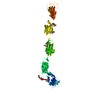
| ||||||||
|---|---|---|---|---|---|---|---|---|---|
| 1 | 
| ||||||||
| 単位格子 |
|
- 要素
要素
-タンパク質 , 1種, 1分子 A
| #1: タンパク質 | 分子量: 55192.984 Da / 分子数: 1 / 由来タイプ: 組換発現 / 由来: (組換発現)   Homo sapiens (ヒト) / Variant (発現宿主): GntI-/- and EBNA1-expressing / 参照: UniProt: P20917 Homo sapiens (ヒト) / Variant (発現宿主): GntI-/- and EBNA1-expressing / 参照: UniProt: P20917 |
|---|
-糖 , 5種, 7分子 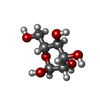
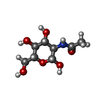

| #2: 多糖 | alpha-D-mannopyranose-(1-3)-[alpha-D-mannopyranose-(1-6)]beta-D-mannopyranose-(1-4)-2-acetamido-2- ...alpha-D-mannopyranose-(1-3)-[alpha-D-mannopyranose-(1-6)]beta-D-mannopyranose-(1-4)-2-acetamido-2-deoxy-beta-D-glucopyranose-(1-4)-2-acetamido-2-deoxy-beta-D-glucopyranose |
|---|---|
| #3: 多糖 | alpha-L-fucopyranose-(1-6)-2-acetamido-2-deoxy-beta-D-glucopyranose |
| #4: 多糖 | 2-acetamido-2-deoxy-beta-D-glucopyranose-(1-4)-2-acetamido-2-deoxy-beta-D-glucopyranose |
| #5: 糖 | ChemComp-MAN / |
| #6: 糖 |
-詳細
| Has protein modification | Y |
|---|
-実験情報
-実験
| 実験 | 手法:  X線回折 / 使用した結晶の数: 1 X線回折 / 使用した結晶の数: 1 |
|---|
- 試料調製
試料調製
| 結晶 | マシュー密度: 7.9 Å3/Da |
|---|---|
| 結晶化 | 温度: 291 K / 手法: 蒸気拡散法, シッティングドロップ法 詳細: Crystals were grown from protein that was modified by reductive lysine methylation. Protein was concentrated to 8.4 mg/mL, which was mixed 1:1 with reservoir solution. Crystals grew in a ...詳細: Crystals were grown from protein that was modified by reductive lysine methylation. Protein was concentrated to 8.4 mg/mL, which was mixed 1:1 with reservoir solution. Crystals grew in a condition containing 200 mM NaOAc and 20 % PEG3350 (w/v). PH範囲: 7.5 |
-データ収集
| 回折 | 平均測定温度: 100 K |
|---|---|
| 放射光源 | 由来:  シンクロトロン / サイト: シンクロトロン / サイト:  PETRA III, EMBL c/o DESY PETRA III, EMBL c/o DESY  / ビームライン: P14 (MX2) / 波長: 0.97553 Å / ビームライン: P14 (MX2) / 波長: 0.97553 Å |
| 検出器 | タイプ: DECTRIS PILATUS 6M-F / 検出器: PIXEL / 日付: 2013年12月15日 |
| 放射 | プロトコル: SINGLE WAVELENGTH / 単色(M)・ラウエ(L): M / 散乱光タイプ: x-ray |
| 放射波長 | 波長: 0.97553 Å / 相対比: 1 |
| 反射 | 解像度: 4.3→114.62 Å / Num. obs: 15430 / % possible obs: 100 % / 冗長度: 35.7 % / Rmerge(I) obs: 0.115 / Net I/σ(I): 15.6 |
| 反射 シェル | 解像度: 4.3→4.81 Å / 冗長度: 36.9 % / Rmerge(I) obs: 3.937 / Mean I/σ(I) obs: 1.3 / % possible all: 100 |
- 解析
解析
| ソフトウェア |
| ||||||||||||||||||||||||||||||||||||||||||||||||||||||||||||||||||||||||||||||||||||||||||||||||||||||||||||||||||||||||||||||||||||||||||||||||||||||
|---|---|---|---|---|---|---|---|---|---|---|---|---|---|---|---|---|---|---|---|---|---|---|---|---|---|---|---|---|---|---|---|---|---|---|---|---|---|---|---|---|---|---|---|---|---|---|---|---|---|---|---|---|---|---|---|---|---|---|---|---|---|---|---|---|---|---|---|---|---|---|---|---|---|---|---|---|---|---|---|---|---|---|---|---|---|---|---|---|---|---|---|---|---|---|---|---|---|---|---|---|---|---|---|---|---|---|---|---|---|---|---|---|---|---|---|---|---|---|---|---|---|---|---|---|---|---|---|---|---|---|---|---|---|---|---|---|---|---|---|---|---|---|---|---|---|---|---|---|---|---|---|
| 精密化 | 構造決定の手法:  分子置換 分子置換開始モデル: 1URL, 4FRW, 1CS6, 3P3Y, 2YD6 解像度: 4.3→114.579 Å / SU ML: 0.64 / 交差検証法: FREE R-VALUE / σ(F): 1.34 / 位相誤差: 42.57 / 立体化学のターゲット値: ML
| ||||||||||||||||||||||||||||||||||||||||||||||||||||||||||||||||||||||||||||||||||||||||||||||||||||||||||||||||||||||||||||||||||||||||||||||||||||||
| 溶媒の処理 | 減衰半径: 0.9 Å / VDWプローブ半径: 1.11 Å / 溶媒モデル: FLAT BULK SOLVENT MODEL | ||||||||||||||||||||||||||||||||||||||||||||||||||||||||||||||||||||||||||||||||||||||||||||||||||||||||||||||||||||||||||||||||||||||||||||||||||||||
| 精密化ステップ | サイクル: LAST / 解像度: 4.3→114.579 Å
| ||||||||||||||||||||||||||||||||||||||||||||||||||||||||||||||||||||||||||||||||||||||||||||||||||||||||||||||||||||||||||||||||||||||||||||||||||||||
| 拘束条件 |
| ||||||||||||||||||||||||||||||||||||||||||||||||||||||||||||||||||||||||||||||||||||||||||||||||||||||||||||||||||||||||||||||||||||||||||||||||||||||
| LS精密化 シェル |
| ||||||||||||||||||||||||||||||||||||||||||||||||||||||||||||||||||||||||||||||||||||||||||||||||||||||||||||||||||||||||||||||||||||||||||||||||||||||
| 精密化 TLS | 手法: refined / Refine-ID: X-RAY DIFFRACTION
| ||||||||||||||||||||||||||||||||||||||||||||||||||||||||||||||||||||||||||||||||||||||||||||||||||||||||||||||||||||||||||||||||||||||||||||||||||||||
| 精密化 TLSグループ |
|
 ムービー
ムービー コントローラー
コントローラー



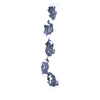
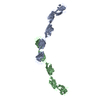

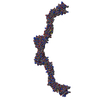



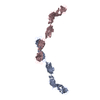

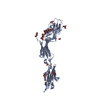




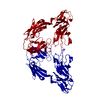
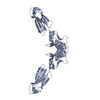

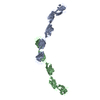
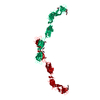
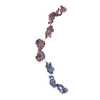
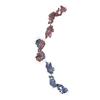
 PDBj
PDBj